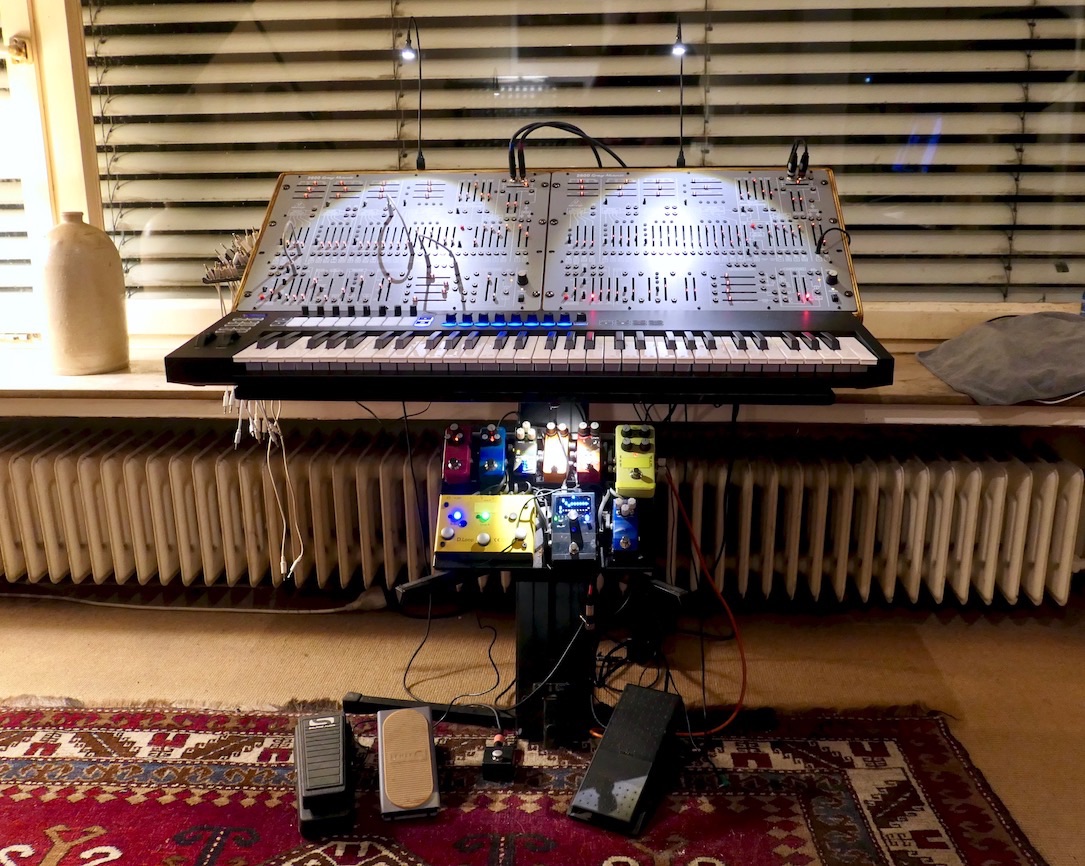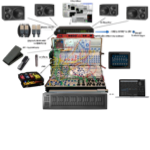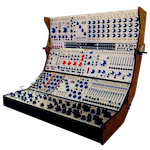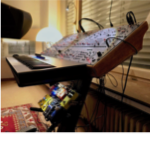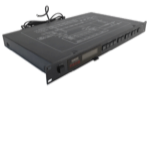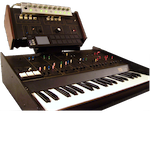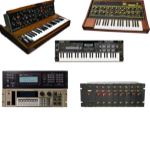Filterbanks and FX
Synthesizers need Effects Units! FX-Pedals are loved for the synthesizer as well, but they rather come in smaller quantities than for guitarists, since synthesizers already have filters, waveshapers, etc.. However, with these tiny FX-Pedals, exciting colors and a distinct individualization of the instrumental tone can be achieved.
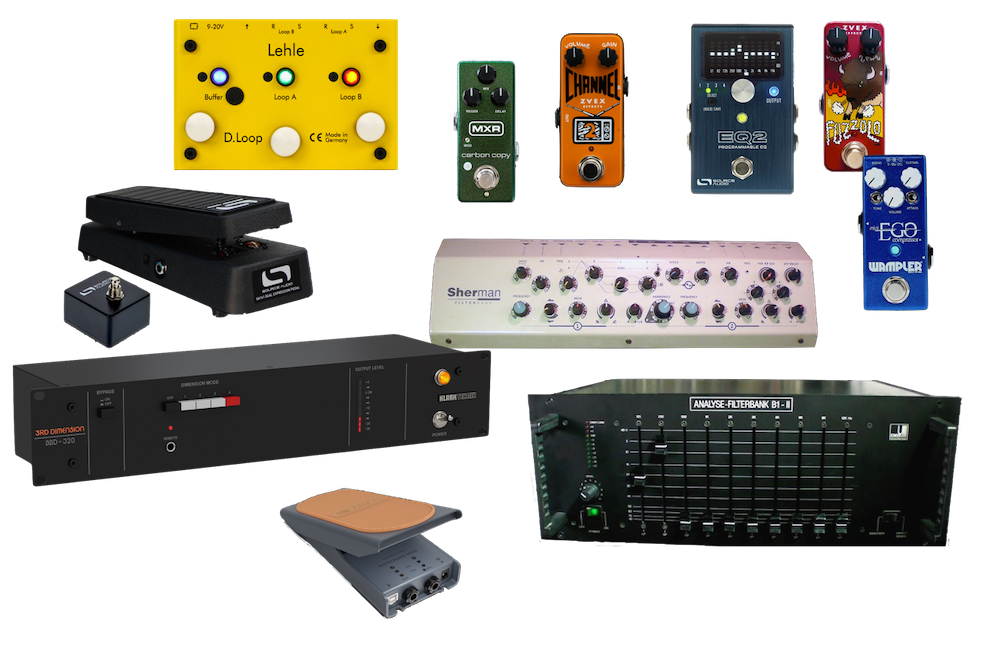
And sometimes it's not even small boxes, but full-grown 19 inch equipment.
Filterbanks
EMS Analyse Filterbank B1-II
EMS (Electronic Music Studios) is a European giant of electronics (in history, not the corporate realm). The VCS3 and Synthi A(KS) have been used by artists from Stockhausen to Pink Floyd. This Filterbank however is rather rare to find and wasn't developed at EMS UK, but in Germany. As far as I know, it is closely associated with Ludwig Rehberg, the German EMS grand seigneur. The mono Filterbank has slopes of up to 57dB /Oct and this alone makes it far from other filterbanks. The amazing sound and the wonderful sliders allows a maximum of musicality. The Penny & Giles 104mm faders are simply super fine - I have never used better ones. They adjust even a little bit better than you could do yourself.
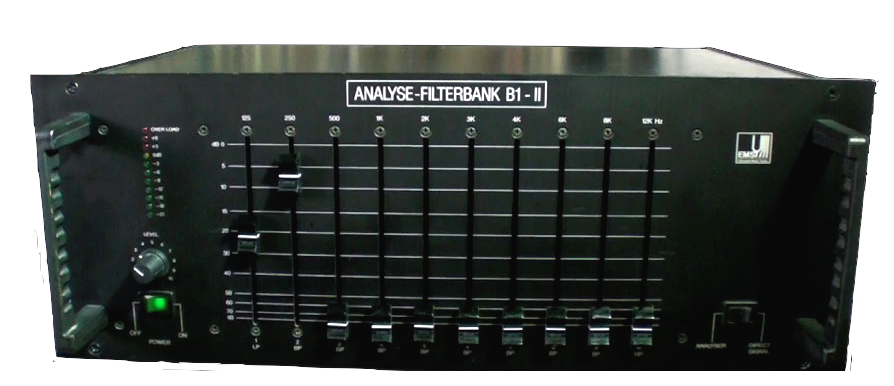
It's an adventure to take out frequency bands like with a scalpel. As implied by the name "Analysis Filterbank": sonically this Filterbank is absolutely clean. Not a bit of background noises. It was my secret weapon to make the MiniMoog no longer to sound like Moog (hardly any other device will manage that!). The Filterbank is especially good for preparing footage, because if you don't want to process it further (especially pitch manipulation), you'll always hear the same frequency bands. This becomes memorized after only a short time and is perceived as a kind of chord that is always the same. Therefore, it is good to subsequently shift the filtered material into the harmonic context of the actual music. This is not a weakness, but occurs with every "fixed filter bank". This is much more apparent with such extreme slopes, compared to "normal" 24dB filters.
This might sound somewhat like times gone by and "tape-cutting techniques", yet the results that can be achieved with this Filterbank are without comparison in my ears. I'm usually very fond of "destroyer filters", but such a delicate, even caring frequency cut works like a complementary color and certainly doesn't hurt! Moreover, the sounds are striking. They do have their very own magic.
EMS Text
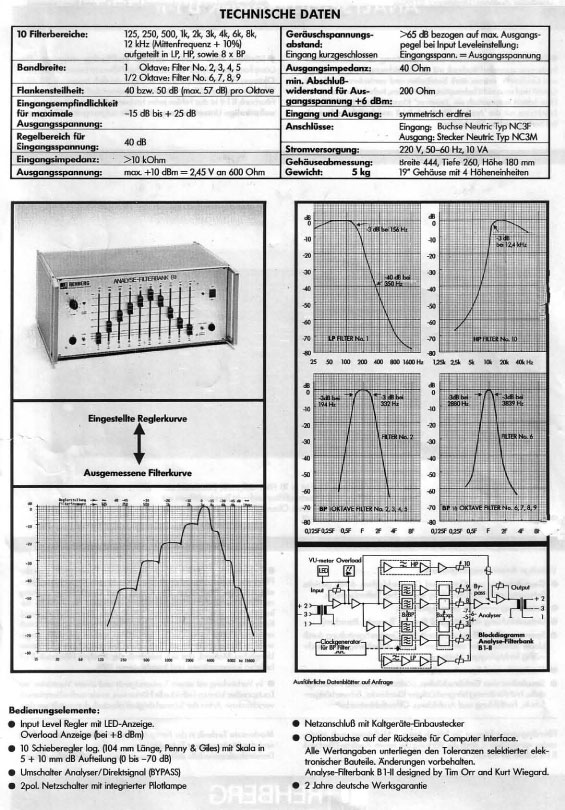 The design of these filters is extremely sloping. The attenuation of the low-pass and high-pass filters is better than 40 dB/octave; that of the band-pass filters is even significantly better than 50 dB/octave (maximum 57 dB/octave). A characteristic feature of the B1-II Analysis Filter Bank is the absence of any audible inherent noise and the complete suppression of any filter channel that has not been attenuated.
The design of these filters is extremely sloping. The attenuation of the low-pass and high-pass filters is better than 40 dB/octave; that of the band-pass filters is even significantly better than 50 dB/octave (maximum 57 dB/octave). A characteristic feature of the B1-II Analysis Filter Bank is the absence of any audible inherent noise and the complete suppression of any filter channel that has not been attenuated.
Design of sound and noise colors through targeted emphasis and/or attenuation of specific partial tone ranges.
Equalization within a signal path.
Suppression of noise [Hum, Rumble, Noise].
Spontaneous access to sound and noise shaping through ideal sliders with extremely long operating length and uniformly smooth-running mechanics.
Sound and speech analysis.
Due to the extreme slopes of the filters as well as the long control travels, very individual methods of sound and noise design are possible. A clear scale division allows the simple reconstruction of different filter curves (equalization curves).
Complex vibrational processes, such as speech sounds, mechanically generated sounds or noise structures, reveal a completely unfamiliar spectrum of colors with flowing transitions. A new sonic material that can be composed and combined arbitrarily within the Analysis Filter Bank B 1-II.
Sherman Filterbank 1
Belgian Tank.

Sherman filterbanks are now well known. It quickly became known for merciless sounds - a LoFi filterbank with a strong expression. Some of the very early "Abusers" - the user manual is called Sherman "abuser manual" - are Björk, the Chemical Brothers, David Bowie, Lenny Kravitz or The Prodigy.
Of formerly four Shermans (2x Sherman 1 and 2x Sherman 2), I have only kept one. My choice fell on the Sherman 1, which has fewer parameters, but is even more merciless. I only use it as a destroyer - for other applications I prefer other filters. As a destroyer, Sherman 1 is unbeatable.
Actually, it is hardly controllable and its values are not really convincing - but to rasp the sounds good values are not the right direction. Sherman filterbanks play everything down to 0 Hz - this can also be dangerous to the amplifiers - thus, it's a really dangerous kind of weapon!
Chorus
3rd Dimension BBD-320
After the "2600 Gray Meanie", the "BBD-320" from Klark Teknik is another "Behringer device" that has reached me, since Behringer/Music Tribe had acquired the Klark Teknik company as well. The "BBD-320 3rd Dimension" is a kind of SMD clone (miniaturized components) of the "Roland Dimension D SDD-320" from 1979. This device is often called a Chorus - I would add, it is possibly THE Chorus of Chorus haters.
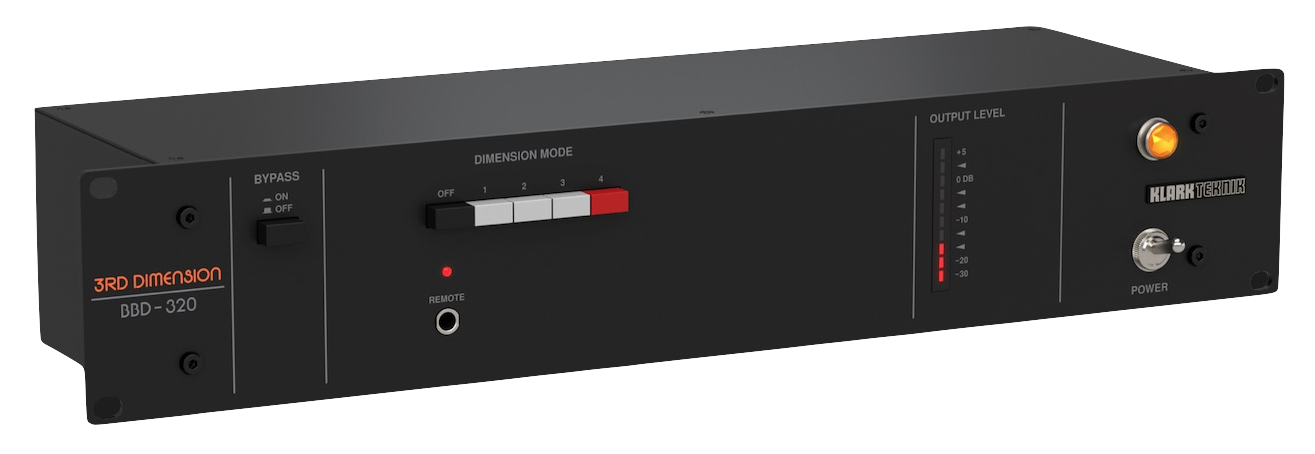
Strictly speaking, it is a Bucket Brigade Delay, therefore "BBD" and it is a most welcome clone, whose role model, the "Dimension D" has its followers to this day and takes a special position, since the chorus effect it produces does not have the typical Chorus Shimmer, or "beats" of a typical chorus (what some just love and others hate so much), but it actually only changes the spaciousness of the incoming signal. Hence the term "Dimension" in the name, I guess. This effect is so subtle that there's a saying that it's only really noticeable when it's switched off and lacking. There is some truth to this.
This processor is also particularly popular for turning mono into stereo sounds. This is made possible via a "mono mode", i.e. a cross circuit. Unfortunately, the switch for this is located at the back of the device. Here the first thought of a modification emerges.
First of all, this is not a loop-through effects processor like the FX-Pedals. The balanced inputs already indicate that it prefers to live in/on a buss. There is not that much to adjust: besides Power and Bypass, there are four pushbuttons (white and red) that apply different variation depths. It is also possible to activate more than one button simultaneously. Using the Remote inlet on the front, the unit can also be enabled and disabled with a Footswitch or Sustain pedal, e.g. from a Pedalboard.
At €148.-, this thing is a real bargain, and it sounds very well out of the box. Nevertheless, the mono mode switch on the back was an unfortunate decision, despite all the love for the original. There will surely be a modding proposal for it soon. I particularly like the fact that the BBD-320 is not as noise-prone as the Roland SSD-320 of 1979.
3rd Dimension BBD-320 MOD
And it gets even better: Tony Allgood, known for his company "Oakley Sound Systems" within the synth-scene, has developed a modification that allows the BBD-320 to overcome even the final small differences to the Dimension D SDD-320 - and all without any noise. In fact, in certain settings, the BBD-320 has a tendency to a thinner sound (the typical chorus sound), while the Roland original clearly portrays "more body".
 The modification (photo) is also provided through a website. For this purpose the BBD-320 has to be sent to Leeds in England. There, the 10 SMD resistors and 2 SMD capacitors will be exchanged and the resistor diodes will be connected in series.
The modification (photo) is also provided through a website. For this purpose the BBD-320 has to be sent to Leeds in England. There, the 10 SMD resistors and 2 SMD capacitors will be exchanged and the resistor diodes will be connected in series.
The tweak will lengthen the Delay Times in all modes and will increase the Modulation Depth in Mode 1. The difference can be heard very well in the audio samples provided on that page. Anyway, I'll send my BBD-320 to England soon...
The FX-Pedalboard
For almost 30 years I had not used any FX pedals - except for a fuzz box. But for my project to "rebuild" my old ARP 2600 setup from the 80s with the B-2600 synth, it was necessary to get some more FX pedals and a pedalboard had come into focus again, because the B-2600 wasn't supposed to be integrated into my computer synth setup, like MOTM and Buchla, but mainly to be played "standalone", as an independent instrument (without computer), just "the way it used to be"...
Thus, I have built myself a pedalboard in 2021 - which, however, I do not switch with my foot, but primarily via MIDI or by hand. The FX pedals allow a considerably improved and more multi-faceted shaping of the synthesizer sounds.

In my setup, the Pedalboard is located in the "aux path" of the synthesizer, on the 2600 it is between the filter and VCA, on the Buchla it is an insert in the Matrix Mixer. This means that the sounds first run back into the synthesizer - so they have a VCA or LPG to pass through before they are sent to the amp and speaker. The board is laid out in Mono and has Boost, Overdrive, Fuzz, Compressor, 2x EQ, 2x Delay (analog and digital) and Reverb. The effects are organized in two loops, Loop 1 Fuzz, Overdrive and Loop 2 Delays. I don't use the stereo Phaser (top right, yellow) in the Pedalboard loop, but only behind the "Stereo" OUT of the B-2600.
Looper
Lehle D.Loop SGoS
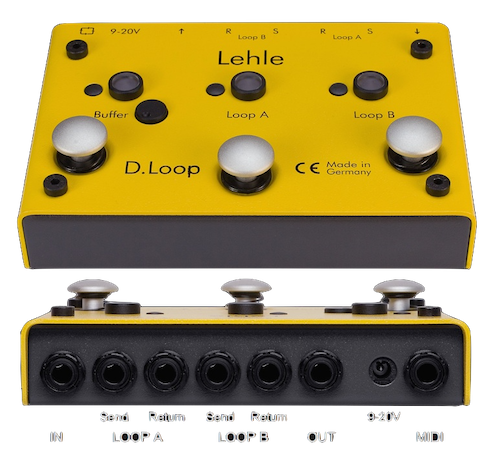 It's not an "audio looper" (sampler). Send/Return paths are also called "loop". The D.Loop has two loops (A+B) and a buffer, which is provided with a booster (up to max. +12dB). In addition, the D.Loop is equipped with MIDI, allowing the switching to be sent, or - for me a blessing - the eight possible switching states (presets) can be recalled via MIDI.
It's not an "audio looper" (sampler). Send/Return paths are also called "loop". The D.Loop has two loops (A+B) and a buffer, which is provided with a booster (up to max. +12dB). In addition, the D.Loop is equipped with MIDI, allowing the switching to be sent, or - for me a blessing - the eight possible switching states (presets) can be recalled via MIDI.
"SGoS" stands for "Second Generation of Switching".
For the large switches, three switch combinations (Buffer and Looper A/B On/Off) can be set ("stored"). The small buttons next to the LEDs can be used to manually activate or deactivate buffers and loops individually.
The D.Loop is switched via relays and, in order to keep everything clean and crisp, the signal is being muted in ms-range when switching (which is not audible), before it is transmitted again in the new configuration. I have measured it once: to avoid MIDI messages being swallowed, there should be 75ms between MIDI PGM change commands. For me this is definitely fast enough!
Lehle Boxes are little masterpieces! You immediately perceive that. The whole - modular - concept quickly makes it clear that everything was thought through to the end and the implementation was uncompromising. The box will accept mono ( balanced / unbalanced) or stereo signals (TRS) - even CV signals for modular synthesizers can be routed, which makes the D.Loop also interesting. The D.Loop is also flexible in terms of power supply: 9 to 20 volts DC may be connected.
Presets can be easily stored on the D-Loop - the operation is kept very simple and intuitive. On the device itself, 3 presets can be called up (3 switches). Up to 3 Lehle boxes can be linked and all switches can be used as program buttons. With two of these boxes, 6 presets can be called up via the switches, with three boxes, 9. The switches can send either Pgm 11-13, 14-16 or 17-19. However, all 8 possible switching states of a box can also be stored and recalled via MIDI. If they are stored e.g. as Pgm 1-8, own configurations (Pgm 11-19) can be stored within the Boxes.
 For enabling bidirectional MIDI communication using a TRS jack cable, Lehle makes use of a trick: Lehle boxes are always in "receive mode". Only by pressing a switch a "PGM send" is triggered. To extend this bidirectionality to my Max patches, I made a "dangerously looking" (and for this application only) cable, with which the menu in Max (with all 8 switch positions) is updated to the current position, each time a switch is pressed on the D.Loop box.
For enabling bidirectional MIDI communication using a TRS jack cable, Lehle makes use of a trick: Lehle boxes are always in "receive mode". Only by pressing a switch a "PGM send" is triggered. To extend this bidirectionality to my Max patches, I made a "dangerously looking" (and for this application only) cable, with which the menu in Max (with all 8 switch positions) is updated to the current position, each time a switch is pressed on the D.Loop box.
Since the MIDI cable built by Lehle (left in the picture) came along with my D.Loop (a second-hand purchase) and D.Loop both receives and transmits program change - depending on whether the (DIN) MIDI plug is in an In or Out MIDI socket - and because I can look at the MIDI processes exactly with Max, I built myself this TRS jack to 2x MIDI. For this purpose the three needed wires of both DIN plugs are simply put together, so they are identical. Together with the MidiLink mini interface it does work - but I also got a cheap USB to MIDI interface cable with which it doesn't work. With the MidiLink I can press the three switches on the D.Loop and Max receives the current position, or I just recall all eight possible positions of the D.Loop from MAX.
By the way, the switching of the relays is clearly audible/perceptible. People with an affinity for technology will love this because it is an indication of the fine inner life inside the box, although for quiet chamber music, e.g. violin and live electronics, it might be a hindrance. However, with such quiet music usually no distortion is used and therefore this problem is rather "very relative".
The Buchla can be heard in the video. The Lehle D.Loop is switched via MIDI. If you listen carefully, you can also hear the slight distortion of the booster (buffer of the D.Loop) at the beginning.
The Booster in the buffer of the Lehle SGOS
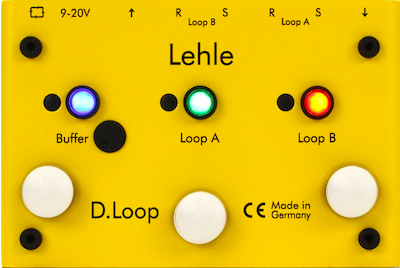 Ein Buffer dürfte bei Synths eher selten benötigt werden, jedoch ist der Buffer des Lehle D.Loop-SGoS auch als Booster zu gebrauchen - und das macht sehr feine, harmonische Verzerrungen möglich. Gerade vor den zwar guten, aber doch "etwas leblosen" digitalen Delay- oder Reverb-Boxes macht das den Unterschied! Auf einmal klingen diese Teilchen wie 1965 und bekommen Charakter! Aber total kontrolliert - nicht durch Zufall und auch ganz ohne Rauschen! Das bringt eine massive Aufwertung, jedenfalls nach meinem Ermessen.
Ein Buffer dürfte bei Synths eher selten benötigt werden, jedoch ist der Buffer des Lehle D.Loop-SGoS auch als Booster zu gebrauchen - und das macht sehr feine, harmonische Verzerrungen möglich. Gerade vor den zwar guten, aber doch "etwas leblosen" digitalen Delay- oder Reverb-Boxes macht das den Unterschied! Auf einmal klingen diese Teilchen wie 1965 und bekommen Charakter! Aber total kontrolliert - nicht durch Zufall und auch ganz ohne Rauschen! Das bringt eine massive Aufwertung, jedenfalls nach meinem Ermessen.
Since the booster position will in most cases be held in a fine-tuned position, the flat potentiometer knob is ideal because it doesn't move as easily as a potentiometer cap during transport - it's more like a trimmer that can be adjusted by hand (instead of a screwdriver).
Such a (good) Booster seems to be the appropriate way to bring digital Delays and Reverbs into one's own sonic conception. The +12dB boost is far too much for me, since the signal already arrives relatively loud - at the most I boost about 3-5 dB.
Since I got the Lehle D.Loop, I'm quite happy with my TC electronic boxes, because now I can boost the signal and slightly distort it. They suddenly sound more "right" to my ears. Previously I kept them directly into the synth and while I was pleased, I was far from being satisfied. The sound was simply too clean and a bit boring. With the Lehle Booster, the sound gets its own (wonderful) coloration and thus contrasts much better in the overall sound image! I want my Pedalboard to be on fire! The D.Loop just makes it possible for me!
EQ
Source Audio SA 270 - One Series EQ2
 This EQ is seriously spectacular! It is designed in stereo, but the two curves can also be used in parallel or in series. With ±18 dB (on each band, it can be a bit more punchy than you'd expect. It features a switch or pedal connection, combines the clarity of a graphic EQ with the advantages of a parametric EQ - including an adjustable resonance! The EQ band frequencies of the sliders can also be freely determined, just like the Q Factor, as well as being moved via pedal or MIDI. In addition, there's a Noise Gate, Limiter, an extra adjustable +12 dB Clean Boost, and even a Tuner in the EQ2. The EQ2 has four Preset Buttons, yet maintains 128 Presets via MIDI or USB. An Editor can be attached via USB (Mac, Windows, iOs and Android) and there are - very instructive - Presets available as downloads. My list may not be complete - but the EQ2 is indeed a very impressive device.!
This EQ is seriously spectacular! It is designed in stereo, but the two curves can also be used in parallel or in series. With ±18 dB (on each band, it can be a bit more punchy than you'd expect. It features a switch or pedal connection, combines the clarity of a graphic EQ with the advantages of a parametric EQ - including an adjustable resonance! The EQ band frequencies of the sliders can also be freely determined, just like the Q Factor, as well as being moved via pedal or MIDI. In addition, there's a Noise Gate, Limiter, an extra adjustable +12 dB Clean Boost, and even a Tuner in the EQ2. The EQ2 has four Preset Buttons, yet maintains 128 Presets via MIDI or USB. An Editor can be attached via USB (Mac, Windows, iOs and Android) and there are - very instructive - Presets available as downloads. My list may not be complete - but the EQ2 is indeed a very impressive device.!
An EQ on the pedalboard of a synth is really worth its weight in gold - even more so if it is capable of doing that much, as the EQ2 does. It is probably the most "influential" pedal on my board! A sort of frequency corset can be imposed on the synthesizer, making entirely new timbres feasible. The character of the synth can be completely altered, the "illumination" makes anything far more nuanced in detail. The havoc of the Fuzz can be showcased better, or the input of the Overdrive can be fed with a tuned frequency package to get the desired timbres. As a result, sounds are becoming far more reminiscent of instruments than of the synth - the "sound" of the instrument is becoming far more nuanced and individual. On my board, one mono block sits between the Fuzz and Overdrive, and the second between the output of the D.Loop and the Reverb, before sending the signal back to the synth's VCA.
The EQ2 reminds me of a Max patch I created for the Buchla ( Input with a parametric EQ) before I got the "Model 227e" (System Interface /Mixer) - and for me the EQ2 is a bit like a Max patch in a box, and that's good, because it allows you to do this without a computer. The sound characteristic of a synthesizer can be brought on point much better when using the EQ2!
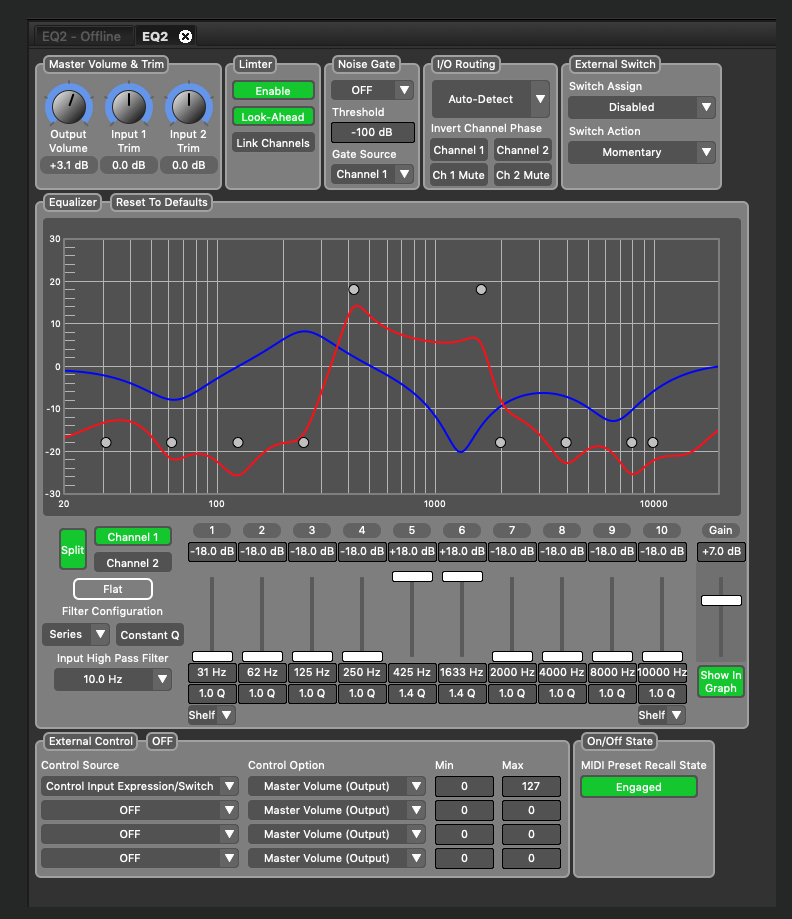 A quick glance at the editor: very clear and concise, it shows more clearly what's inside the EQ2. The curves can be "swapped" or faded back and forth by a pedal - there are, after all, two curves on each preset! A maximum of 4 parameters can be selected and then moved together via pedal control. For instance, this allows for a very precise Wah tweak. The ±18 dB, Resonance, Booster and Limiter can also make the Wah more aggressive according to your wishes. The control can also be performed via MIDI instead of using the analog pedal.
A quick glance at the editor: very clear and concise, it shows more clearly what's inside the EQ2. The curves can be "swapped" or faded back and forth by a pedal - there are, after all, two curves on each preset! A maximum of 4 parameters can be selected and then moved together via pedal control. For instance, this allows for a very precise Wah tweak. The ±18 dB, Resonance, Booster and Limiter can also make the Wah more aggressive according to your wishes. The control can also be performed via MIDI instead of using the analog pedal.
Because I enjoyed the EQ2 that much, I also ordered the Switch and the Pedal from Source Audio. The Pedal has a short control path, which I like better for a Wah, than the long path of the Yamaha FC-7, however, there are still too many negative points that made me doubt: the whole construction, with toothed belt (!), seems more like from the 60s. Questionable seems to me the "poor" potentiometer on the side of the pedal. I also did not like the use of a 3.5mm mini cable (TRRS) on the Pedal, nor the quality of the plugs, wires and jacks - the supplied 6.3mm TRS cable is so loose that you have to worry it could drop out. The not ceasing squeak of the Pedal actually makes up the rest for me.
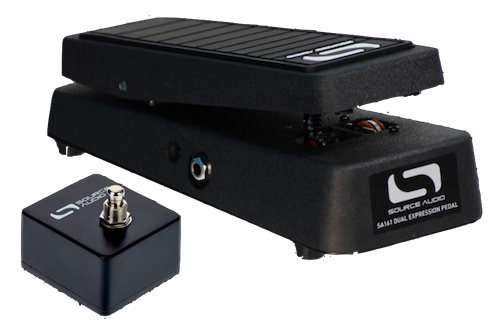 I kept the "Source Audio Dual Expression Pedal" anyway, because it controls "more aggressively" - which is welcome when using the Wah. Of course, the Wah can also be controlled with a MIDI pedal - this works very well, but is not as aggressively executable as via an analog 50k Pedal (which is processed by the EQ2 in 10bit resolution).
I kept the "Source Audio Dual Expression Pedal" anyway, because it controls "more aggressively" - which is welcome when using the Wah. Of course, the Wah can also be controlled with a MIDI pedal - this works very well, but is not as aggressively executable as via an analog 50k Pedal (which is processed by the EQ2 in 10bit resolution).
If you simply "control" a frequency (or Q or volume) instead of an expressive Wah, it's better done via pedals with a larger control travel - including using MIDI. It feels a bit more like indirect control - similar to the difference between a Pratt Read and a MIDI keyboard.
The Source Audio Switch is also very expensive with € 45.-, but outwardly it has a perfect appearance - and it can be operated without any "click" noises. In the Editor it can be set how it should behave ("Momentary" or "Latching"). The switch stays with me, although it is used as a portamento switch on the Gray Meanie. My previously used, € 6.- Mini Sustain pedal always slipped away, was suddenly upside down and caused noise through the resonating plastic housing when used. The Source Audio Switch is much smaller, much heavier, doesn't slip away as easily and doesn't make any noise when you push it. I gave the built-in switch a significant upgrade with a Lehle Switch BTN. It is even smoother and has a broader mushroom head, which does not drill into the foot when you use it as a Sustain Pedal.
MIDI Control and Editor
About the MIDI control of the EQ2: the resolution is of course significantly limited compared to a 50 kΩ pedal (MIDI=7bit=128 steps). While the app and the 50 kΩ control make 0.2dB steps at the "EQ band levels", the MIDI control has only 36 steps here, i.e., at ±18dB that's exactly 1dB per step, only one fifth of the 50 kΩ resolution. It's not audible and seems to be prevented by a "slew", but I think it's nice to know. For the Q there are 95 steps available (from 0.5 to 10.0) and for the Frequency all 128 steps available for the range 20-20,000 Hz. However, one works over a predefined spectrum with the pedal, e.g. from 300 - 2000 Hz, and there everything is put into perspective again with the resolution.
The software is well intended, but still seems to be unfinished and it reveals some "weird" bugs. For example, if you try to call the MIDI address "Source Audio EQ2", it is not recognized. The reason: behind the name there are eleven blanks that are not visible, but are required to be there. This doesn't look too confident. Also the firmware update from 1.14 to 1.15 only worked on the eighth try. Before that, it was aborted by an "upgrade failed" message. When 1.15 was finally installed, the message came: "Please install the current firmware 1.14.". It requires a lot of patience.
The picture clearly shows that nine sockets are quite a lot for any FX pedal.
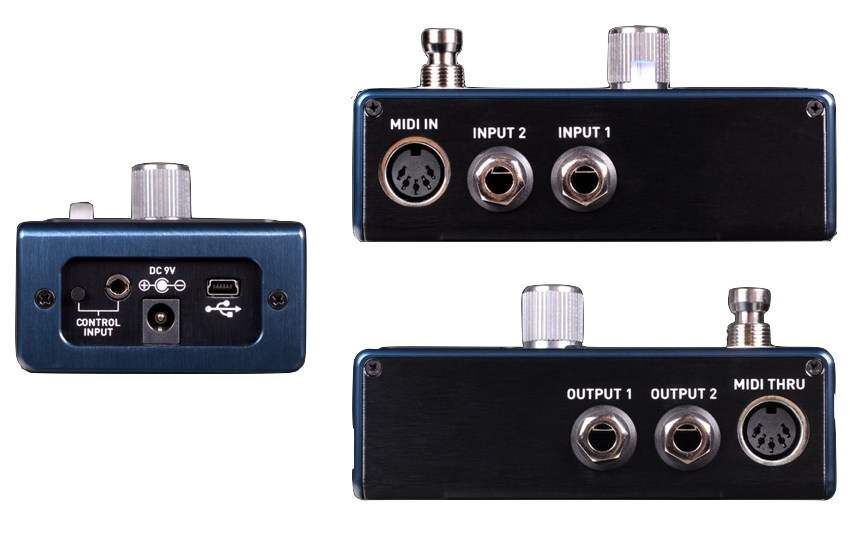
Maximum Input Level: +6.54 dBV = 8.76 dBu = 2.12 V RMS = 6.0 V pp
–– Full Scale Output Level: +6.54 dBV = 8.76 dBu = 2.12 V RMS = 6.0 V pp
–– Input Impedance: 1 Mega Ohm (1 MΩ)
–– Output Impedance: 600 Ohm (600 Ω)
–– 110 dB DNR Audio Path
–– 24-bit Audio Conversion
–– 56-bit Digital Data Path
–– Universal Bypass (relay-based true bypass or analog buffered bypass)
DELAY (Analog)
MXR Carbon Copy Mini
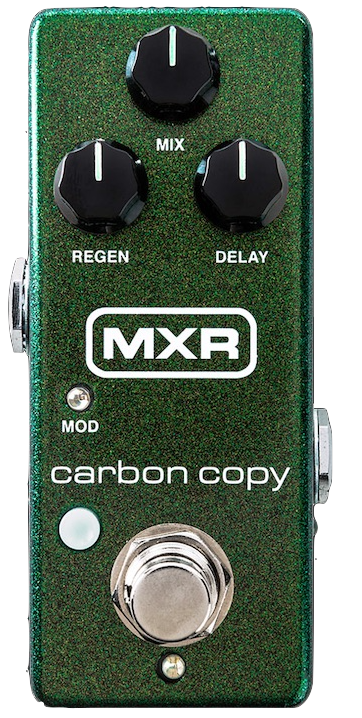 This is a proper sounding delay! And it sounds big! I don't ever want to let it out of my hands again. Especially with short delay times, most digital delays sound a bit metallic, cold and rather unpleasant. This is where the old analog bucket brigade circuit scores. The time warping and feedback also feels properly. It makes you feel good.
This is a proper sounding delay! And it sounds big! I don't ever want to let it out of my hands again. Especially with short delay times, most digital delays sound a bit metallic, cold and rather unpleasant. This is where the old analog bucket brigade circuit scores. The time warping and feedback also feels properly. It makes you feel good.
The difference to digital Delays, apart from the sound, is certainly the significantly shorter delay time: with the Carbon Copy Cloner this is a maximum of 600 ms - thus a tenth of the maximum time of the Flashback Mini (Digital Delay).
The larger, sonically identical "MXR Carbon Copy" has spread within a very short time and has become a "standard". The newer "Carbon Copy Mini" still has a miniature switch on the side, with which it can be set to the more treble-emphasized "Bright Mode".
I'm not sure if I'll find a use for it, because switching is fiddly and only works with a small tool. Especially on the tightly built pedalboards, this switch is also quite difficult to reach. Sonically I locate the need of the Bright Mode more likely in the Rockabilly Scene.
The pedal has a distinctly warm and naturally organic sound in "normal" mode. The modulation, which can be activated manually, works discreetly and does not make the delay wobble. However, if you prefer, you have the option to change the depth and speed of the modulation inside the pedal. The small blue LED under the switch is violent.
Especially if you just want to give the sound some space - which a synthesizer basically doesn't provide - a good Bucket Brigade Delay is much more helpful and invigorating than a Reverb. I knew from the first time I heard this delay that I wouldn't be returning it. A great-sounding Bucket Brigade Delay that also exists as a Mini Pedal - what could you want more?!
DELAY (Digital)
tc electronic Flashback 2 Mini
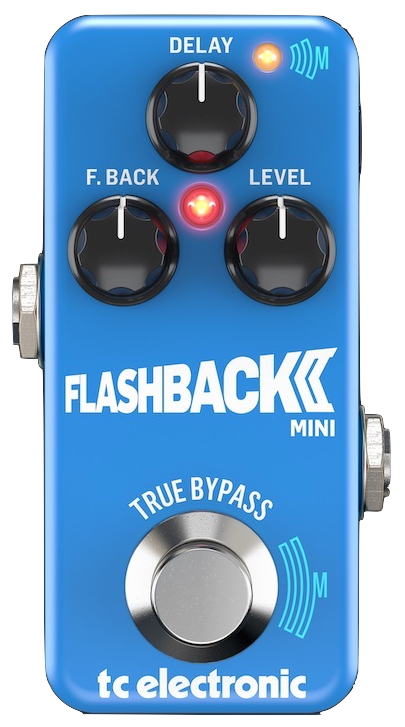 The first re-encounter with FX pedals happened years ago with TC Electronic's Flashback Mini - I wanted a reversed Delay on the Synth, before the sound goes into the audio interface.
The first re-encounter with FX pedals happened years ago with TC Electronic's Flashback Mini - I wanted a reversed Delay on the Synth, before the sound goes into the audio interface.
These little TC Electronic "mini" boxes are quite amazing. Qualitatively without compromises compared to the larger variants of the same manufacturer, they are on the cutting edge. There is a mini-USB input on the side and the units actually allow a lot of settings to be made via the associated editor! The various settings can then be stored as presets and you can dump one of them into the device via USB.
Although this restricts the joy of experimentation somewhat - thus for "tinkering" will need an iPad or computer with a USB connection from the pedal. However, the editor is very easy to use and the wealth of parameters and algorithms is more abundant than you would expect. For playing I actually always use the same four or five presets.
Meanwhile I have changed to the Flashback 2 Mini. It has 2 new algorithms and new is also the "Mash" function - which I do not use however.
Reverb (Digital)
tc electronic Hall Of Fame 2 Mini
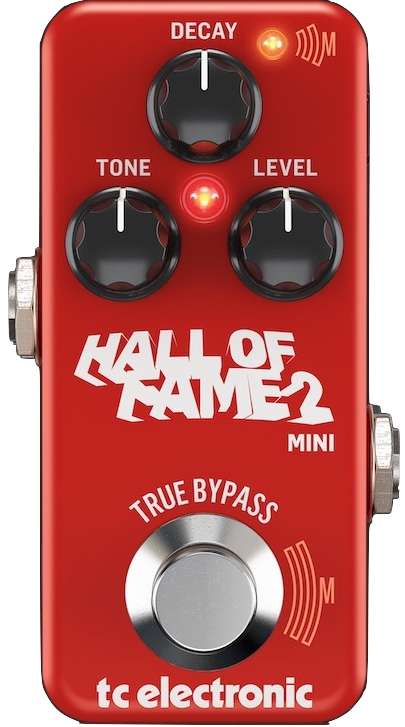 What would all the effects be without Reverb?! Following the positive start with the Flashback Mini, I also ordered the HOF (Hall Of Fame) Reverb, at that time still mkI. Also amazingly good! Without booster roughening maybe a little boring - too clean. For me, the discovery of the boost impact on the "HOF" by the Lehle D.Loop was a redemption: here was the "old" Reverb sound that I had been looking for.
What would all the effects be without Reverb?! Following the positive start with the Flashback Mini, I also ordered the HOF (Hall Of Fame) Reverb, at that time still mkI. Also amazingly good! Without booster roughening maybe a little boring - too clean. For me, the discovery of the boost impact on the "HOF" by the Lehle D.Loop was a redemption: here was the "old" Reverb sound that I had been looking for.
Again, the "TonePrint" editor is needed for any editing: All the parameters of the connected pedal can be seen here - and they are a lot! Another very good feature is that multiple assignments can be set up for the hardware pots - e.g. "Kill Dry" for the max. position of the controller - well thought out and really practice-oriented.
The successor model "Hall Of Fame 2" is now available (picture). The HOF mkII is clearly better, if only because it now has three knobs instead of one. However, I never use the new "Mash" function of the new TC generation: pulling a whole arm out of circulation to press a button for a certain effect seems too overkill - since I don't operate the parts with my foot... The three controls "Decay", "Tone" and "Level" were decisive for the purchase - and the replacement of the old "HOF".
In my case, the HOF2 Reverb sits behind the output of the D.Loop, so it is not in any loop, but behind both loops. It "glues together" the very different sounds of the two loops (A: distortion, B: delay) better when switching quickly. For "Live" it is certainly sufficient and in the studio I can use the "True Bypass" of the pedal in order to use a better Reverb.
Since I added the Carbon Copy Delay, I use both TC Minis (Delay and Reverb) significantly less than before.
Overdrive
Zvex Channel 2
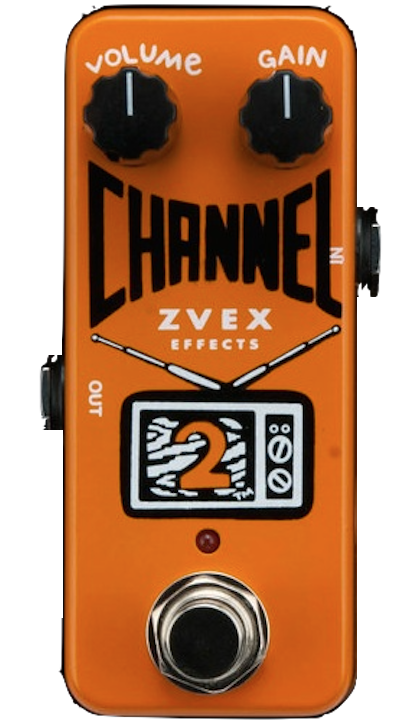 Finally an Overdrive pedal which I really like - great for use with synths. ZVEX's Channel 2 produces a rather "warm" type of Overdrive that works well at low volumes - and doesn't "kick in" like a Fuzz or sound too much like an electric guitar. With the Volume Pedal connected ahead of it, a sound similar to woodwinds can be created: the louder it gets, the stronger the harmonic overtones will appear. Ideal if there is an EQ between the Volume Pedal and the Overdrive. Duduk, Oboe, Bassoon or (Bass-) Clarinet are the sounds that come to mind.
Finally an Overdrive pedal which I really like - great for use with synths. ZVEX's Channel 2 produces a rather "warm" type of Overdrive that works well at low volumes - and doesn't "kick in" like a Fuzz or sound too much like an electric guitar. With the Volume Pedal connected ahead of it, a sound similar to woodwinds can be created: the louder it gets, the stronger the harmonic overtones will appear. Ideal if there is an EQ between the Volume Pedal and the Overdrive. Duduk, Oboe, Bassoon or (Bass-) Clarinet are the sounds that come to mind.
The cozy sound of the Overdrive has a slightly narrowed frequency spectrum and a midrange boost. At full volume, it's already a bit nasty with the Synth. Here, again, an preceding EQ is like flavoring. Adding a Compressor ( prior to the EQ) is also useful. The Channel 2 allows for fantastic timbres.
I previously used to have Channel 2 before the Fuzz as well - not to overdrive, but to possibly lower the volume! However, I keep the Fuzz and Overdrive in the same FX Loop because I almost never need them to distort at the same time. Channel 2 addressed the "Fuzz volume problem" by closing the volume almost completely. Actually, I had no problems with the Fuzz even without the Channel 2, but by extremely turning down the volume, you can get even "more" (broken sound) out of the Fuzz - meaning: more destruction. Just perfect.
In Channel 2, half the control range (7-12 o'clock) of the Volume control is available to attenuate the signal. If Volume and Gain are set to "0", no signal will pass through "Channel 2". Thus it is indeed a true "Channel".
Fuzz
Zvex Fuzzolo
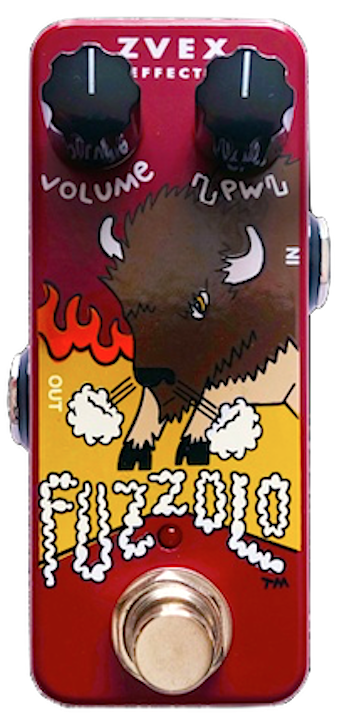 Perhaps the most sensitive point is reached with this genre of Distortion, because there are sonic overlaps with the Synth (Waveshaping / Rectifying) and there are probably far more Fuzz pedals, than possible Fuzz flavors. Everything is based on two basic characteristic Fuzz types: Germanium and, since the late 60s, Silicon. This is a Silicon Fuzz.
Perhaps the most sensitive point is reached with this genre of Distortion, because there are sonic overlaps with the Synth (Waveshaping / Rectifying) and there are probably far more Fuzz pedals, than possible Fuzz flavors. Everything is based on two basic characteristic Fuzz types: Germanium and, since the late 60s, Silicon. This is a Silicon Fuzz.
It is made by the Fuzz Mega Specialist ZVEX and it is named Fuzzolo. It not only fits the size of my Mini Pedalboard perfectly - also the sound is what I was expecting from my Fuzz.
A Fuzz transforms the incoming sound into rectangular Waveforms, but not as dignified as a Waveshaper, but rather violently. The Fuzz effect was modeled for the sound of a broken mixing console channel. Besides the Volume, the Fuzzolo has just the Pulse Width control (right), a modulator that can be used to change the pulse-wave length so that the positive and negative portions of the sound ("up and down") are no longer the same length. At maximum setting, this can go as far as phase cancellation, which then acts like a gate. The sound dies, breaks up or is torn off. A very nice demolition!
Part of the reason that the Fuzzolo works better with Synths than other Fuzz pedals is due to the fact that there is a jumper inside the pedal that can be set to work with the values of active pickups, which is also very convenient for Synthesizers.
The most common trouble between a Synth and a Fuzz is the input impedance of the Fuzz, which is usually set to passive pickups. The incoming level from the synth is far too high in such cases.
Fuzz works well at the beginning of an instrument chain - it will sound especially good (destructive) if the current is "not quite enough" (about 7V) or/and if the signal is as attenuated as possible. Guitarists like to dial in the Fuzz via the volume knob on their instrument. This is not quite as feasible with synths - but with Channel 2 (see above) the volume may be adjusted additionally.
I have had a lot of different Fuzz pedals (Fender Fuzz-Wah, EHX Graphic Fuzz, Flying Tomato Fuzz, Spaghetti Western Fuzz, ...). Although many of these pedals sounded fantastic with guitars, they were absolutely unsatisfactory with either E-piano as well as with Synth! In addition, the ambient noises dominated. Fuzz on a piano or a synth is a fundamentally different story, and good/famous Fuzzes don't necessarily sound good on a Synth. While the Fuzz on the guitar is rather "evil", it is rather "broken" on the Synth".
Compressor
Wampler Mini Ego Compressor
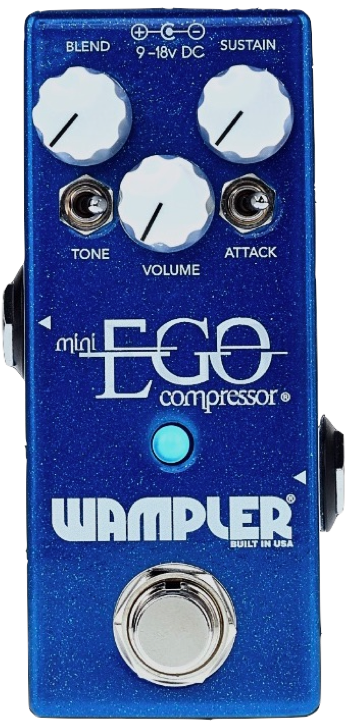 A Compressor may be very helpful, but it makes everything much more complicated.
A Compressor may be very helpful, but it makes everything much more complicated.
On my board, it is placed before the D.Loop, which is the easiest position, as it sits before both the Delay and the Overdrive. However, it must be switched off when using the Fuzz. Especially prior to the Fuzz, a Compressor is absolute poison, because the Fuzz will "jump". Behind the Fuzz the Compressor is very good - but it's playing with fire, since it can lead to extreme noise during pauses - on the other hand, this is exactly what promotes the "dirty atmosphere" of the Fuzz.
A Compressor is also dangerous with very dynamic volumes. Here it quickly destroys the expressivity. For this reason, it is most variable when used at the very front of the chain.
A Compressor is awesome both before and behind the Overdrive (for different purposes). Since the Overdrive doesn't operate with gates, like a Fuzz, but is only driven into and boosted by increasing volume, the Compressor provides more harmonics, which makes the Overdrive stands out better.
Phaser
tc electronic Helix
 Thanks to the Toneprint Editor settings, which make it much simpler to get the Synth and the FX Box working together, I soon had my eyes on TC Electronics' "Helix" when I was looking for a Phaser. However, the trigger for the purchase was the Feedback knob - which is to be found only on a very few FX boxes and which allows significantly more "live electronics" sound. Also the Helix fulfills my wishes and is highly versatile.
Thanks to the Toneprint Editor settings, which make it much simpler to get the Synth and the FX Box working together, I soon had my eyes on TC Electronics' "Helix" when I was looking for a Phaser. However, the trigger for the purchase was the Feedback knob - which is to be found only on a very few FX boxes and which allows significantly more "live electronics" sound. Also the Helix fulfills my wishes and is highly versatile.
At that time I probably would have chosen the Helix Phaser also as a Mini unit (then in mono, like all TC-Minis) - but that was not available. This was my good fortune, because in the meantime I no longer use the Helix in the mono FX loop (in, or on the Lehle D.Loop), but it is now located directly behind the stereo outputs of the Gray Meanie - and now of course in stereo mode. And here (in stereo) Helix not only shows its capabilities much better, but also in the positioning (behind synth, effects and reverb) I prefer it much more, because the „tails" are the best fodder for a Phaser.
It's really astounding how well the TC effect pedals are built - very "precious", without anything negative - also the concept behind the TonePrint pedals appears to be well well thought through.
The Helix was lying around for a long time (because I have Phaser modules in the Buchla and in the MOTM) and now, thanks to the 2600 Gray Meanie, it has gained its first real life.
Power
Cioks DC 7
 The Cioks DC7 seemed to be the only, almost perfect solution for my project, even if it is initially somewhat "overpowered" and also not particularly inexpensive. First I had tried the 70 Euro cheaper Cioks DC8, but immediately realized that it is not suitable for more modern devices with higher mA demand. On the DC 7 all seven outputs are individually adjustable (9V/660mA, 12V/500mA, 15V/400mA, 18V/330mA) and isolated from each other. Multiple devices may also be connected per socket using the DaisyChain method.
The Cioks DC7 seemed to be the only, almost perfect solution for my project, even if it is initially somewhat "overpowered" and also not particularly inexpensive. First I had tried the 70 Euro cheaper Cioks DC8, but immediately realized that it is not suitable for more modern devices with higher mA demand. On the DC 7 all seven outputs are individually adjustable (9V/660mA, 12V/500mA, 15V/400mA, 18V/330mA) and isolated from each other. Multiple devices may also be connected per socket using the DaisyChain method.
But that's not all by any means! The Cioks DC 7 arrives with 12 cables, including one double, one triple (daisy-chain), one with reversed polarity and several, with plugs other than the usual 2.1 hollow plugs. I also purchased additional cables, one for extending, another triple cable, and one for combining two outputs and doubling the volt draw - that is, in order to get 24V from the Power Supply (that's what the MXR 10 Band EQ was asking for). Also there is a doubling cable that keeps the voltage number and just doubles the mA. On top of that, there's a USB charging output on the DC 7 with 5V/1A - that's truly real-world and very convenient. For me it supplies the iPad with power. Two "expanders" from Cioks - the Cioks 4 and the Cioks 8 - are available for the 24V output socket, which can be loaded with another 2A.
the next picture at the right the state of the current transformation can be seen. The base is a disused "laptop holder" (36 x 24 cm) taken from a keyboard table. I have drilled a couple of holes into it in order to bolt the feet, the Lehle D.Loop and the CIOKS DC7. Should something not work, the first handle will be to lift the board on the right side and see if all indicator lights are lit correctly.
Truly an impressive power supply! And in case I run out of outputs or mA against all expectations, I don't need a new power supply, but only one or both expanders: Cioks4 and Cioks8 - together 12 more outputs of equal power, just as from the Cioks DC 7!
With the exception of the D.Loop, which runs on 18V on my board, all the stompboxes on the board could be run on just one DC 7 output! They are only connected so "generously" because of the existing cables and the limited current requirement - so much more can be connected. The 9V devices require only 538 mA combined (3x TC = 4 x 100 mA, 2x Zvex, 10 and 15 mA, Carbon Copy 26 mA, Wampler 22mA and the EQ2 165 mA) from the 660 mA at the 9V output of the CIOKS DC7. The Volume Pedal takes 12V - but just 5 of the 500 mA at 12V. The single output that is loaded with more than 50% is the 18V output - the D.Loop consumes 195 of the available 330 mA.

For my own interest, I also connected my Eurorack remnant case (with aj TipTop power supply) on a test drive. All was working just fine!
Expression Pedal (with USB)
Lehle Dual Expression
Expression Pedals used to be always problematic - finally Lehle has brought out one - and it seems to be the "jack of all trades" among the Expression Pedals. When reading the manual it becomes evident why the engineering skills of Burkhard Lehle are outstanding and make up the difference:
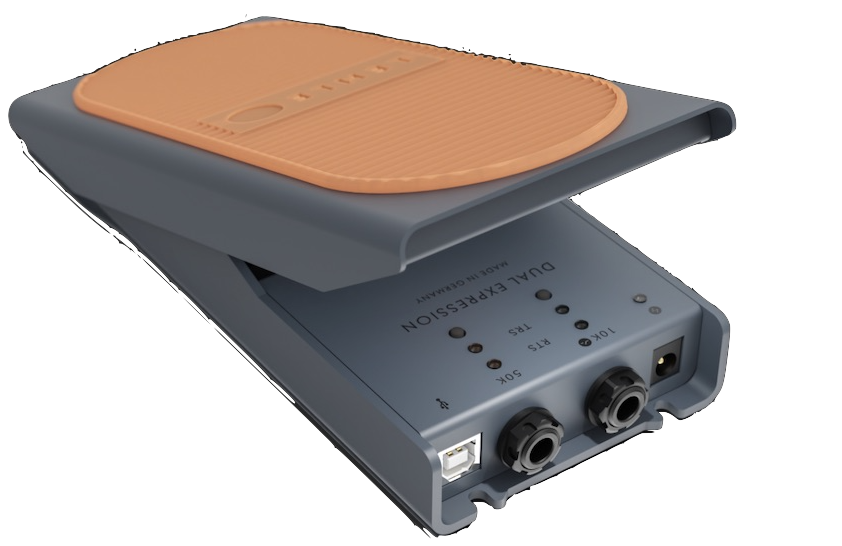 "The two outputs can control almost all common devices with inputs from 5k to 100k, no matter if TS, TRS or RTS - the polarity of the outputs can be set and saved via a soft button. The 10k output can also be used as a pushbutton or switch, for instance in order to switch the channel of an amplifier when the pedal is fully down, or to control any function when it is connected to a switching input of a digital multi-effect. The USB jack lets you send MIDI data to a computer for controlling midi compatible software."
"The two outputs can control almost all common devices with inputs from 5k to 100k, no matter if TS, TRS or RTS - the polarity of the outputs can be set and saved via a soft button. The 10k output can also be used as a pushbutton or switch, for instance in order to switch the channel of an amplifier when the pedal is fully down, or to control any function when it is connected to a switching input of a digital multi-effect. The USB jack lets you send MIDI data to a computer for controlling midi compatible software."
Yes, it has a USB output - unfortunately ( for now?) it's limited to MIDI CC 11 (7bit/128steps). Of course I would have rather preferred Pitchbend, because it is also available in 14bit (16384 steps) resolution. Hope remains for a firmware upgrade that also allows the upgrade to Pitchbend. The "calibration" of the pedal is also fantastically solved - but it is quite fiddly (with the mini push buttons), because you have to press the buttons by hand and then set the minimum and maximum position of the pedal within 5 seconds. This would be much more targeted to be done via software, so that the pedal can remain on the foot all the time. In addition, one could then possibly save "ideal" calibrations and send them to the pedal for different applications, as a SysEx message. You wouldn't have to recalibrate it every time - and have a different approximation to the optimum each time. As an example, for "volume" you want a maximum control travel, for "wah" you want it to be as short as possible. Furthermore, it would be nice being able to put a curve behind the (linear) course of the control path in order to adapt the pedal to the effect being controlled (of course, this can be easily done in "Max"). Nevertheless: It is the very best expression pedal that I have ever used!
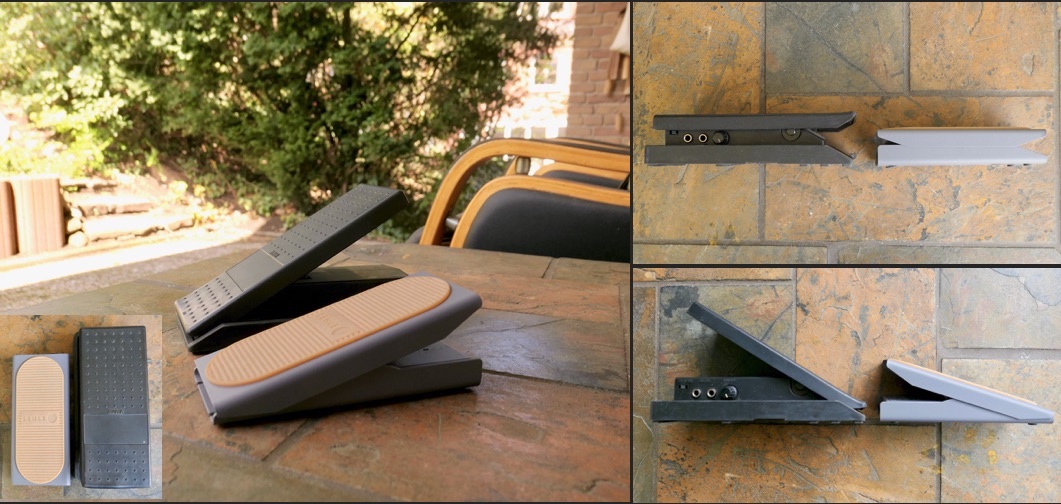 The design is very "modern". It is very small in size for an Expression Pedal (20x9x4,7 cm), light in weight (766 g) - and it is made of metal - virtually wear-free. It can handle signals up to 10V - even CV. It produces absolutely ZERO mechanical noise (!!!) when controlling. Power supplies may be 9V to 15V, polarity doesn't matter, because it is recognized by the pedal. To the "big-footers": even with a shoe size of 15, it's awesome to control!!! I am thrilled - and since the D.Loop already a self-confessed "Lehle-ian". The photo shows a size comparison with the Yamaha FC-9.
The design is very "modern". It is very small in size for an Expression Pedal (20x9x4,7 cm), light in weight (766 g) - and it is made of metal - virtually wear-free. It can handle signals up to 10V - even CV. It produces absolutely ZERO mechanical noise (!!!) when controlling. Power supplies may be 9V to 15V, polarity doesn't matter, because it is recognized by the pedal. To the "big-footers": even with a shoe size of 15, it's awesome to control!!! I am thrilled - and since the D.Loop already a self-confessed "Lehle-ian". The photo shows a size comparison with the Yamaha FC-9.
Volume Pedal
Yamaha FC9
After a long break I have reactivated one of my, almost 30 years old Yamaha FC-9 pedals for this task - the last years it was used exclusively (without power) as a CV Pedal - and it is (sounds) much better than I was afraid. Before the audio signal from the 2600 enters the Pedalboard, it has to pass through here. It is also powered by the Cioks DC 7 (12V).
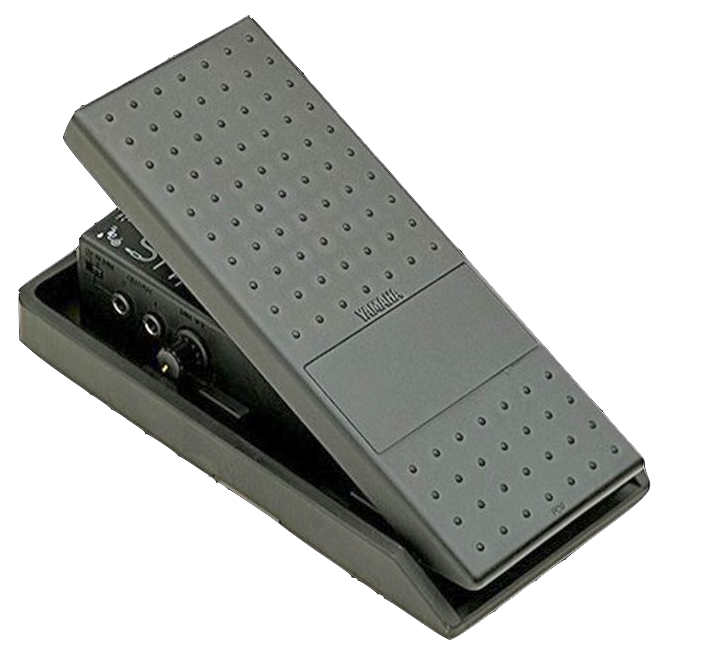 Besides its CV capability, it has another good bonus parameter: the minimum volume can be adjusted with the potentiometer on its side. This makes it perfect for a Pedalboard and also allows it to be used as a "dynamics pedal", just riding through the saturation levels. Very good!
Besides its CV capability, it has another good bonus parameter: the minimum volume can be adjusted with the potentiometer on its side. This makes it perfect for a Pedalboard and also allows it to be used as a "dynamics pedal", just riding through the saturation levels. Very good!
Unfortunately, the FC-9 is no longer built. Behringer has a similar looking "FC100 MkII" for a third of the price on the market, which can also be switched in polarity. However, the VCA of the predecessor model FC100 was lousy. As a CV pedal it is certainly welcome (at that price) - this also happened well with the predecessor.
MIDI Interface (USB)
Miditech MIDIface II Thru
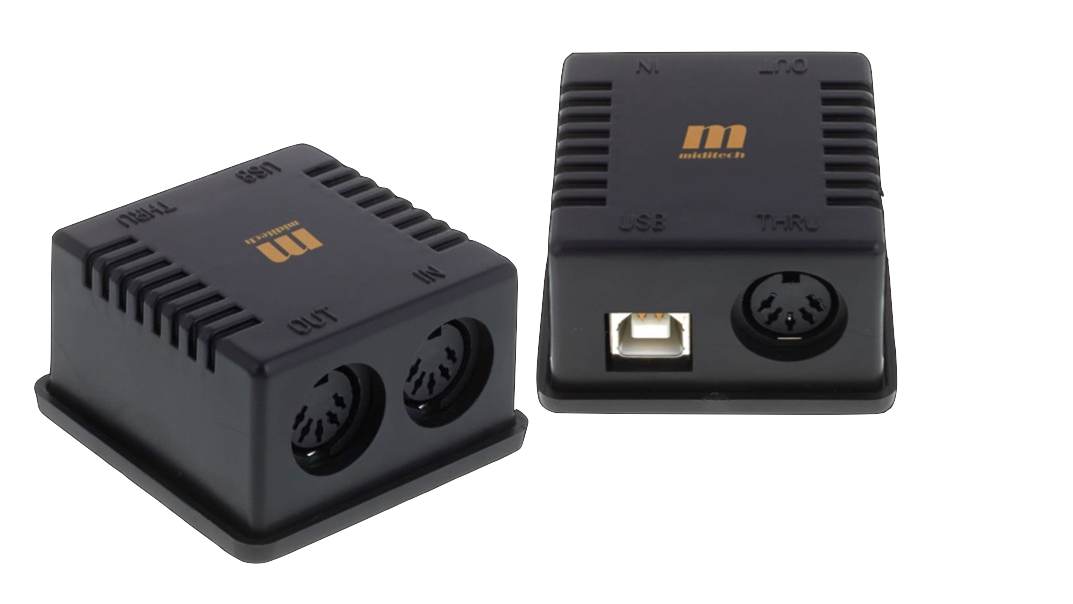 Years ago I bought a MIDI interface (mini) especially for the Pedalboard: the MIDIFACE II THRU 1x1. It provides MIDI In, Out and Thru and can handle the Lehle I/O (MIDI short-circuit cable) - which not all cheap USB MIDI interfaces can do. Due to the design / housing shape it is easy to attach to a board and only one (USB) cable is required to be connected to the board- or disconnected for transport. A very clean solution.
Years ago I bought a MIDI interface (mini) especially for the Pedalboard: the MIDIFACE II THRU 1x1. It provides MIDI In, Out and Thru and can handle the Lehle I/O (MIDI short-circuit cable) - which not all cheap USB MIDI interfaces can do. Due to the design / housing shape it is easy to attach to a board and only one (USB) cable is required to be connected to the board- or disconnected for transport. A very clean solution.
Here you can see the bottom of my Pedalboard - and the MIDI interface with its "special cable" (I/O) to the D.Loop. Meanwhile, the Source Audio EQ2 (with another MIDI receive channel) is connected to the MIDI Thru output and can be controlled extensively. That is, 128 programs, parameter real-time control, crossfade, channel switch and much more. The two MIDI controllable devices (D.Loop and EQ2) are the core of the pedalboard. The lightweight interface is seated firmly beneath the board with Velcro tape.
 I can connect the iPad or the computer using the USB port. Actually, I'm very happy with this MIDI interface - out of 4 "small" MIDI interfaces I own, it's the only one that hasn't had any issues in all these years. These little things keep the joy going.
I can connect the iPad or the computer using the USB port. Actually, I'm very happy with this MIDI interface - out of 4 "small" MIDI interfaces I own, it's the only one that hasn't had any issues in all these years. These little things keep the joy going.
However, I haven't transferred any sysex data yet - many "cheap" interfaces don't like that because they can't buffer the data. I'll try it out on occasion, but I'm afraid it won't work. With this interface, the design of the enclosure was the crucial factor for me - while it was originally intended for MIDI program changes only.
Jack Patcher
Temple Audio Design 4-way Jack Patch Module

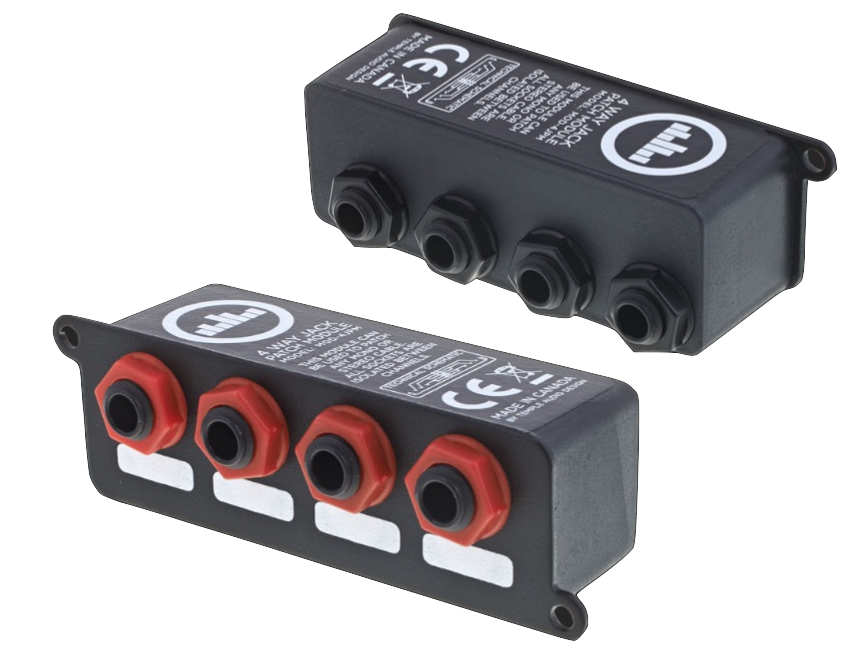 The Temple Audio Design "4-way Jack Patch Module" doesn't do much, but it's the most compact solution for clean and extremely tight wiring on the board.
The Temple Audio Design "4-way Jack Patch Module" doesn't do much, but it's the most compact solution for clean and extremely tight wiring on the board.
This shows how the patch module unfolds in all its glory. The assignments A+B= Synth Main out (L/R), C=FX In, D= FX Out.
Order is half the battle.
In the Wild
